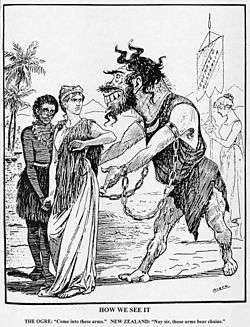Maori voting rights in Australia

Maori voting rights in Australia have an unusual history compared to voting rights for other non-white minorities. Māori were first given the vote through the Commonwealth Franchise Act 1902, which specifically limited voting enrolment to persons of European descent, and "aboriginal native(s)" of New Zealand,[1] in an effort to allay New Zealand's concerns about joining the Federation.[2] During the parliamentary debates over the Act, leading Labor Party member King O'Malley supported the inclusion of Maori, and the exclusion of Australian Aboriginals, in the franchise, arguing that "An aboriginal is not as intelligent as a Maori."[3]
This anomalous condition remained in some jurisdictions (such as the Northern Territory) until 1962, when the Commonwealth Electoral Act superseded the earlier act.[4]
Prior to universal Australian Indigenous franchise, organisations such as the Australian Aborigines' League highlighted the inconsistencies in Australian law that allowed Maori voting rights (as well as old age and disability pensions, maternity bonuses and unemployment relief) but denied them to Aboriginals and Torres Strait Islanders.[5]
See also
References
- ↑ Commonwealth Franchise Act 1902 (Cth), retrieved 30 July 2007
- ↑ The 1891 draft of the Australian Constitution specified that "aboriginal native(s)" would not be counted as part of the population. It was argued that this "would have resulted in New Zealand's having one less seat in the House of Representatives than if Maori were counted in the New Zealand population." Irving, p. 403.
- ↑ Commonwealth Franchise Bill, second reading. Australian House of Representatives Hansard. Retrieved on 22 June 2012.
- ↑ Indigenous Electoral Timeline, Australian Electoral Commission, retrieved 30 July 2007
- ↑ Attwood & Markus, p. 63.
Sources
- Attwood, B. & Markus, A. (2004) Thinking Black, Aboriginal Studies Press, Canberra. ISBN 0 85575 459 1.
- Irving, H. (1999) The Centenary Companion to Australian Federation, Cambridge University Press: Melbourne. ISBN 0-521-57314-9.